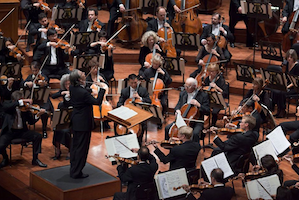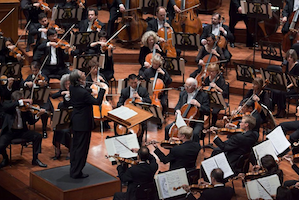
Last week was a busy one, as the San Francisco Symphony opened its season. There was the traditional Opening Night Gala and its associated celebrations — given additional splendor by the fact that, as everyone in San Francisco probably knows, this is Michael Tilson Thomas’ 20th season as music director of the city’s magnificent and beloved orchestra. The Gala concert, last Wednesday, was followed the next evening by the traditional All-San Francisco Concert, for members of more than 100 social service and nonprofit organizations throughout the Bay Area.
And then on Friday, the 2014–2015 concert season officially started. On the program was a repeat of three-quarters of the Gala concert program: both Tchaikovsky’s and Prokofiev’s treatments of Romeo and Juliet, plus Stravinsky’s bouncy Scherzo à la russe. The sensational young British pianist Benjamin Grosvenor rounded out the program with Ravel’s Piano Concerto in G Major.
Season openings and anniversaries of any kind are not generally conducive to musical introspection or experimentation when it comes to concert programming, and this year’s SFS opener was no exception. There is an understandable need, and certainly a tradition, to keep things simple and play it safe. This involves a certain amount of crowd-pleasing, as well as making sure that the entire orchestra is on stage and engaged most of the time.
In that respect, Tchaikovsky’s Fantasy-Overture Romeo and Juliet is a predictable choice, with its elegant melodies, tight structure, and ample opportunity for soloists and sections to put their best foot forward. The same can be said for the scenes that MTT selected from Prokofiev’s ballet score of Romeo and Juliet, which also served as a celebratory reference to the Grammy–award winning recording (on the RCA Red Seal label) made during the conductor’s inaugural season with SFS.
This is repertoire that produces extremely pleasing results in the hands of MTT and his players, and there was plenty to enjoy.
Fortunately, this is repertoire that produces extremely pleasing results in the hands of MTT and his players, and there was plenty to enjoy: the endless flow of the soaring central love theme in the Tchaikovsky, for instance, when the gentle pulse from the horn slowly permeates the orchestra; or the meditative quietude of the “Balcony Scene” from Prokofiev’s ballet music.
Yet, appealing and beautiful as it was, exciting it was not, and the second half of the concert was even a bit unsatisfying.
That was not the case right before intermission, when Grosvenor took to the stage for Ravel’s Piano Concerto in G Major. Grosvenor comes laden with personality and a powerful sense of purpose. His playing leaves no room for ambiguity and exudes an air of “this is the way it is supposed to be”: naturally flowing and transparent.
At 22, Grosvenor has already built a remarkable career. Decca Classics signed him in 2011 as the youngest British musician ever (and the label’s first British pianist in almost 60 years); and in 2012 he won two Gramophone Awards, “Instrumental” and “Young Artist,” which made him Gramophone’s youngest-ever double award winner.
Grosvenor managed to create the impression that he was completely improvising his solo passages. … This shows a degree of musical instinct and understanding that is rare.
Ravel’s piece has obvious jazz-influences, especially in the bluesy melodic twists of the first movement. Still, Grosvenor managed to create the impression that he was completely improvising his solo passages, such as the lengthy cadenza in the first movement and the introduction of the central Adagio.
This shows a degree of musical instinct and understanding that is rare, even among older and more experienced concert pianists — although Grosvenor can by no means be considered “inexperienced,” given that he first performed the Ravel concerto at age 11. Please bring him back to San Francisco as often as possible, maestro!
The tiny treasure that is Stravinsky’s Scherzo à la russe opened the second half of the concert. The four-minute piece was given an odd and unnecessary additional coda when the entire orchestra suddenly rose to its feet, which only got in the way of savoring the already unexpected ending of Stravinsky’s little musical bon-bon.

